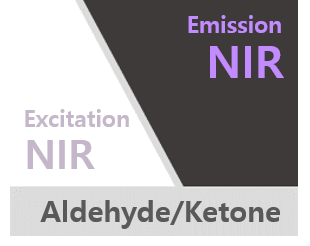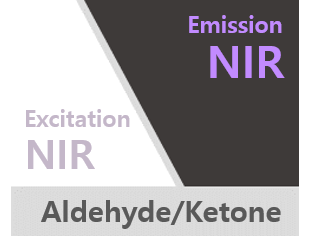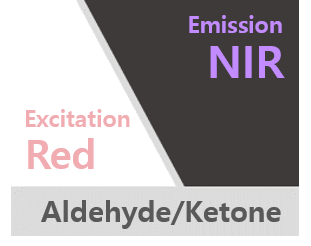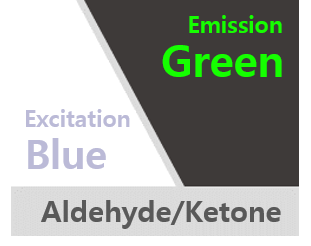
 >
Products
>
>
>
>
Products
>
>
>
- Flamma® Fluors NHS ester
- Flamma® Fluors Sulfo-NHS ester
- Flamma® Fluors Vinylsulfone
- Flamma® Fluors Isothiocyanate
- Flamma® Fluors Maleimide
- Flamma® Fluors Hydrazide
- Flamma® Fluors Dichlorotriazine
- Flamma® Fluors Carboxylic acid
- Flamma® Fluors Amine
- Flamma® Fluors Thiol
- Flamma® Fluors Alkyne
- Flamma® Fluors PEG4-Alkyne
- Flamma® Fluors ADIBO
- Flamma® Fluors Azide
Flamma® 496 Azide
| PACKING UNIT | price |
Lead time |
|---|---|---|
| 1 mg | $121.00 | |
| 5 mg | $320.00 | |
| 25 mg | $840.00 |
Description
Flamma® Fluors 496 Azide is a copper (I)-catalyzed azide-alkyne cycloaddition (CuAAC) reagent of bright green dye induced from fluorescein structure and used to generate a stable fluorescence signal in bioimaging. The azide reactive group is connected to the dye through an amino propyl linkage. The maxima of Ex/Em values are at 496/520 nm, similar to that of Alexa 488 and Fluorescein. Flamma 496 might be excited using 488 nm laser line and displays excellent optical property. Flamma 496 azide couples with an alkyne to form 1,4-disubstituted 1,2,3-triazole inside of living systems without interfering native biochemical processes. Prior to perform CuAAC, the alkyne functionality should be introduced onto counterpart biomolecule by means of chemical or genetic modification. We offer Flamma Fluors 496 Azide as a click chemistry reagent dye for cellular imaging and nucleotide functionalization.
Citation & Reference
1. Jang H, Post-insertion technique to introduce targeting moieties in milk exosomes for targeted drug delivery. Biomaterials Research. 2023 Feb 9;27(1).
2. Yhee, Ji Young. Cancer-targeted MDR-1 siRNA delivery using self-cross-linked glycol chitosan nanoparticles to overcome drug resistance. Journal of Controlled Release 198 (2015): 1-9.
3. Yoon, Hong Yeol. Glycol chitosan nanoparticles as specialized cancer therapeutic vehicles: Sequential delivery of doxorubicin and Bcl-2 siRNA. Scientific reports 4 (2014).
4. Hollis, Christin P. In vivo investigation of hybrid paclitaxel nanocrystals with dual fluorescent probes for cancer theranostics. Pharmaceutical research 31.6 (2014): 1450-1459.
5. Oh, Keun Sang. Accurate sequential detection of primary tumor and metastatic lymphatics using a temperature-induced phase transition nanoparticulate system. International journal of nanomedicine 9 (2014): 2955.
6. Park, Jin Woo. Wide-Ranged Fluorescent Molecular Weight Size Markers for Electrophoresis. Bulletin of the Korean Chemical Society 34.1 (2013): 29-30.
7. Yoon, Hong Yeol. Bioreducible hyaluronic acid conjugates as siRNA carrier for tumor targeting. Journal of Controlled Release 172.3 (2013): 653-661.
8. Yhee, Ji Young. Tumor-targeting transferrin nanoparticles for systemic polymerized siRNA delivery in tumor-bearing mice. Bioconjugate chemistry 24.11 (2013): 1850-1860.
9. Koo, Heebeom. The movement of self-assembled amphiphilic polymeric nanoparticles in the vitreous and retina after intravitreal injection. Biomaterials 33.12 (2012): 3485-3493.
10. Zhu, Lei. Real-time monitoring of caspase cascade activation in living cells. Journal of controlled release 163.1 (2012): 55-62.
11. Huang, Xinglu. Multiplex Imaging of an Intracellular Proteolytic Cascade by using a Broad?Spectrum Nanoquencher. Angewandte Chemie International Edition 51.7 (2012): 1625-1630.
12. Ryu, Ju Hee. Early diagnosis of arthritis in mice with collagen?induced arthritis, using a fluorogenic matrix metalloproteinase 3–specific polymeric probe. Arthritis & Rheumatism 63.12 (2011): 3824-3832.
13. Ibrahim, Basma M. A strategy to deliver genes to cystic fibrosis lungs: a battle with environment. Journal of controlled release 155.2 (2011): 289-295.
14. Xu, Peisheng. Zwitterionic chitosan derivatives for pH-sensitive stealth coating. Biomacromolecules 11.9 (2010): 2352-2358.
OPTION
Total

 log
log My
My Contact
Contact







